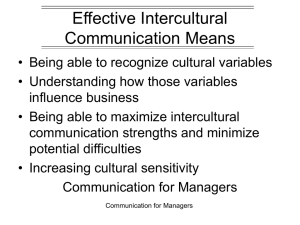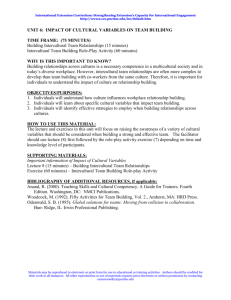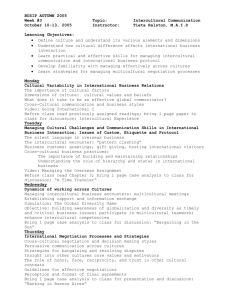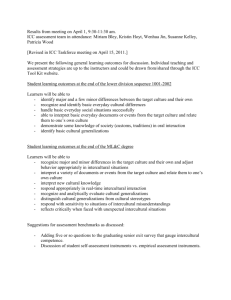Intercultural Communication
advertisement
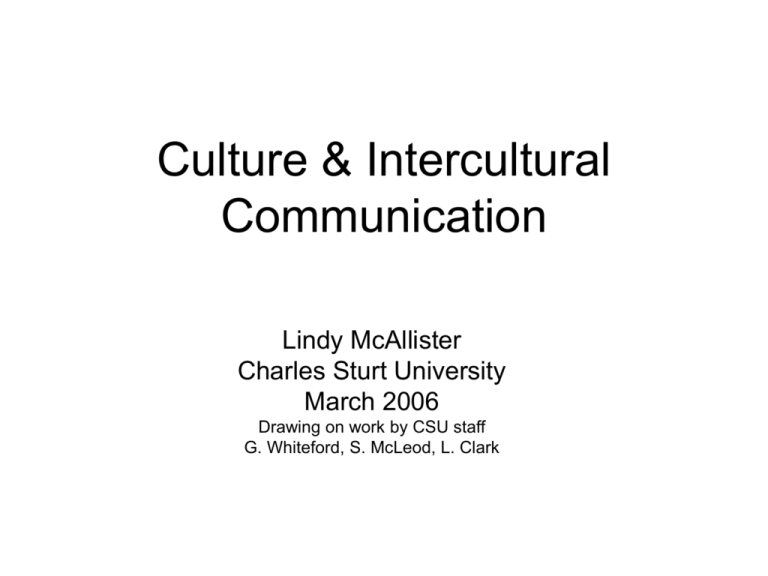
Culture & Intercultural Communication Lindy McAllister Charles Sturt University March 2006 Drawing on work by CSU staff G. Whiteford, S. McLeod, L. Clark What is culture? • Classic definition of culture – “a historically transmitted patterns of meaning embodied in symbols, a system of inherited conceptions expressed in symbolic forms by means of which men communicate, perpetuate and develop their knowledge about and attitudes toward life” (Geertz, 1973, p. 89) What is culture? • More than race or ethnicity • The learned traditions, practices and beliefs that one group of people hold in common • “learned and shared patterns of percieving and adapting to the world” (Mullarvey O’Byrne, 1997) • “system of shared meanings” (Whiteford, 2000) Characteristics of culture • Culture is – Learned – Transmitted inter-generationally – Symbolic – Dynamic – ethnocentric Dimensions of culture • • • • • • Individualism vs collectivism Vertical vs horizontal cultures Active vs passive cultures Universalism vs particularism Instrumental vs expressive Emotional expression vs suppression • Within any culture these dimensions interact in a range of ways Communication and culture • • • • • Beliefs (including stereotypes) Values Attitudes Worldview Patterns of cognition (e.g. wholistic, cyclical vs cause-effect, linear) • Verbal behaviour • Non-verbal behaviour Worldview Points to consider • A culture’s dominant beliefs and attitudes about a human’s place in nature and society • The general pattern of relationships between humans and nature • The relationship between humans and the culture’s supreme being • The supreme being’s power over life and events • Humans’ competitive or cooperative nature • Humans’ expressions of their beliefs • Humans’ myths about the origins of people • Humans’ beliefs in the supernatural • The living patterns in groups • The ways a group uses rituals, ceremonies etc. • Pennington 1985 Overcoming ethnocentrism • Ethnocentrism is “a universal tendency for any people to put its own culture and society in a central position of priority and worth” (Keesing, 1965) • EC becomes a perpetual window through which people of a cultural group interprets and judges all other cultures Overcoming ethnocentrism • Danger is “our way is the right way” • Examples? Being culturally aware • Culture is often not questioned and is taken for granted • To be more aware we need to recognise the differing world views of people and not assume “sameness” • Consider the impact of institutional and professional cultures on behaviour Developing cultural sensitivity • Recognise that your beliefs and actions may be different to others - not necessarily better • Accept that each person has a right to their beliefs, and they feel as strongly about them • Be open to finding out about the traditions, beliefs and practices of others Moving from cultural sensitivity to safety • Cultural safety is a concept developed in New Zealand – relates to the right of people not to have their cultural and religious beliefs compromised in health care – based on the need for knowledge and skills development to underpin behaviour change ie actually DOING things differently Terminology - a brief note • Cross cultural – working across cultures • Multicultural – multiple cultures interacting simultaneously • Intercultural – focuses on the interpersonal interaction between people who are cultural beings Intercultural communication • “occurs whenever a a message that must be understood is produced by a member of one culture for consumption by a member of another culture” (Samovar & Porter, 1997) Intercultural communication • For intercultural communication to work there has to be real and genuine motivation and an ability to transcend ethnocentrism “parties in intercultural communication must have an honest and sincere desire to communicate and seek understanding” Strategies used by students in intercultural interactions • Acknowledge own feelings and responses as a beginning point • Be a learner, be able to be guided • Be respectful • Be resourceful and know when to seek resources/assistance (based on Whiteford, 2000) Issues in Intercultural Communication – Slipping into taken for granted mode – Differing cultural perspectives on authority • Australians are relaxed, but this is not universal – Assuming that if people are not verbalising problems that none exist Issues (cont.) – Wrongly judging social behaviour (e.g., lunchtimes) – Pressuring people to “display” cultural difference when they are not comfortable to do so – Pressuring someone to be a spokesperson for their cultural group Strategies for managing intercultural communication • Provide opportunities for people to give you feedback in a comfortable form (e.g. with colleague there) • Keep communication lines open - even when challenging (often trust issues are involved) Strategies • Communication – word selection – wait time – identify jargon and colloquialisms – paraphrase feedback – multi-level feedback – clarify crucial aspects of session Power in intercultural interactions • At Phu My who holds power? – Senior/junior carers – Doctors/Manager – Sister Marie Huu • Power vested in visiting professionals • Students power – Expert vs student status Exploring yourself & others in intercultural communication • List 5 cultural predictions people in Vietnam might make of you in a ICC context • List 5 individual predictions people in Vietnam might make of you in a ICC context • List 5 cultural predictions you might make of Phu My staff in a ICC context Working with interpreters • • • • Simultaneous vs sequential interpreting Role – interpreter/translator/cultural guide Status of interpreter – training, age, gender Knowledge of context and technical language • Positioning • Giving feedback
